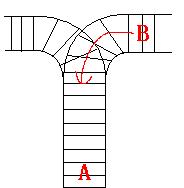Train Problem I
Time Limit: 2000/1000 MS (Java/Others) Memory Limit: 65536/32768 K (Java/Others)
Total Submission(s): 23417 Accepted Submission(s): 8855
Problem Description
As the new term comes, the Ignatius Train Station is very busy nowadays. A lot of student want to get back to school by train(because the trains in the Ignatius Train Station is the fastest all over the world ^v^). But here comes
a problem, there is only one railway where all the trains stop. So all the trains come in from one side and get out from the other side. For this problem, if train A gets into the railway first, and then train B gets into the railway before train A leaves,
train A can't leave until train B leaves. The pictures below figure out the problem. Now the problem for you is, there are at most 9 trains in the station, all the trains has an ID(numbered from 1 to n), the trains get into the railway in an order O1, your
task is to determine whether the trains can get out in an order O2.






Input
The input contains several test cases. Each test case consists of an integer, the number of trains, and two strings, the order of the trains come in:O1, and the order of the trains leave:O2. The input is terminated by the end of file.
More details in the Sample Input.
Output
The output contains a string "No." if you can't exchange O2 to O1, or you should output a line contains "Yes.", and then output your way in exchanging the order(you should output "in" for a train getting into the railway, and "out"
for a train getting out of the railway). Print a line contains "FINISH" after each test case. More details in the Sample Output.
Sample Input
3 123 321 3 123 312
Sample Output
Yes. in in in out out out FINISH No. FINISHFor the first Sample Input, we let train 1 get in, then train 2 and train 3. So now train 3 is at the top of the railway, so train 3 can leave first, then train 2 and train 1. In the second Sample input, we should let train 3 leave first, so we have to let train 1 get in, then train 2 and train 3. Now we can let train 3 leave. But after that we can't let train 1 leave before train 2, because train 2 is at the top of the railway at the moment. So we output "No.".HintHint
题意:有n列火车,只有一个火车站,火车先进站的将会后出站,很显然这是栈(栈跟站音都相同有木有),但并不仅仅只是逆序一下那么简单,题目还包含一层意思,比如说数据3 123 132,如果仅仅只是逆序的话则不满足,但是满足:1号车进站(in),1号车出战(out),2号车进站(in),3号车进站(in),3号车出站(out),2号车出战(out),则同样满足;
同时还应注意:要清空,就是因为没有清空WA了很多次,一言难尽!下次应该注意!
#include<iostream>
#include<stack>
#include<cstring>
#include<cstdio>
using namespace std;
stack <char> a;
int main()
{
int n,i,j,k;
char in[10000],out[10000];
int b[10000],sum1,sum2;
while(scanf("%d%s%s",&n,in,out)!=EOF)
{
while(!a.empty()) //刚开始没有清空就WA了
{
a.pop();
}
memset(b,0,sizeof(b));
j=0;
k=0;
for(i=0;i<n;i++)
{
a.push(in[i]);
b[j++]=0;
while(!a.empty()&&a.top()==out[k])
{
b[j++]=1;
k++;
a.pop();
}
}
sum1=0;sum2=0; //标记in的次数和跟out的次数和是否相等,相等则输出Yes.不相等输出No.
for(i=0;i<j;i++)
{
if(b[i]==0)
sum1++;
else if(b[i]==1)
sum2++;
}
if(sum1!=sum2)
{
printf("No.\n");
printf("FINISH\n");
}
else
{
printf("Yes.\n");
for(i=0;i<j;i++)
{
if(b[i]==0)
printf("in\n");
else if(b[i]==1)
printf("out\n");
}
printf("FINISH\n");
}
}
return 0;
}







 本文探讨了一种解决复杂调度问题的方法,即优化火车进出站顺序,确保所有火车能按照指定顺序顺利进出站。通过实例分析,展示了如何通过引入栈的概念来解决此类问题,并提供了代码实现及输出解析,帮助读者理解并应用到类似场景。
本文探讨了一种解决复杂调度问题的方法,即优化火车进出站顺序,确保所有火车能按照指定顺序顺利进出站。通过实例分析,展示了如何通过引入栈的概念来解决此类问题,并提供了代码实现及输出解析,帮助读者理解并应用到类似场景。
















 205
205

 被折叠的 条评论
为什么被折叠?
被折叠的 条评论
为什么被折叠?








